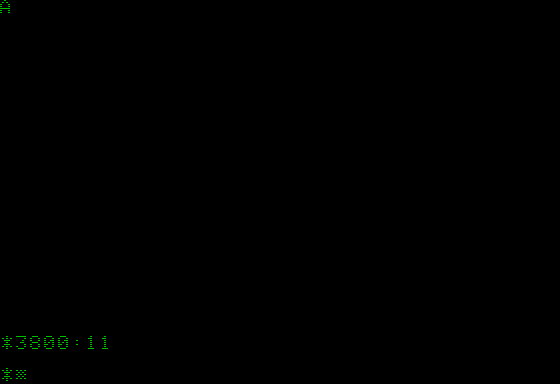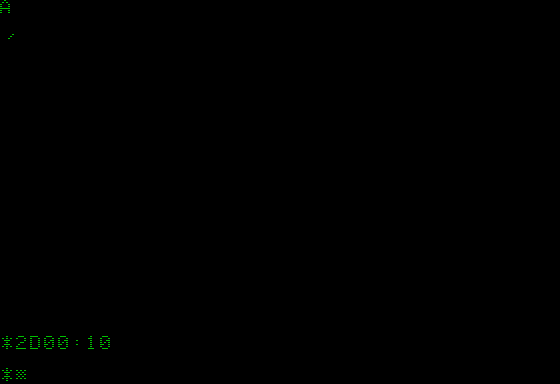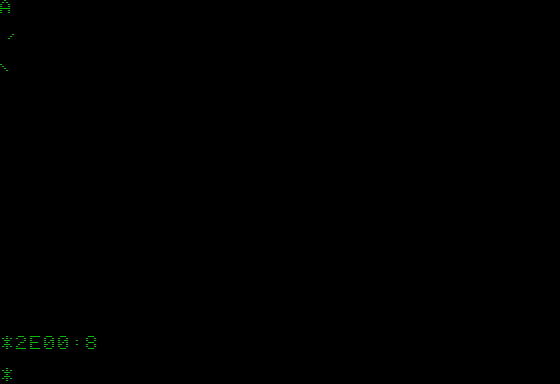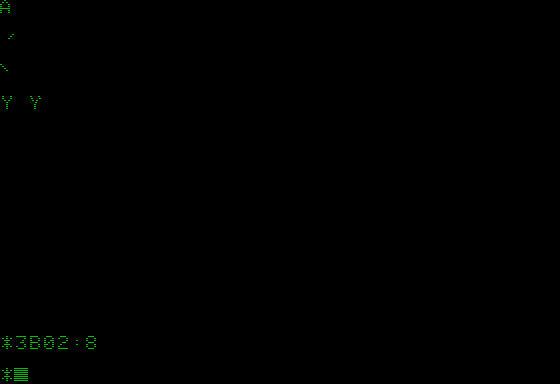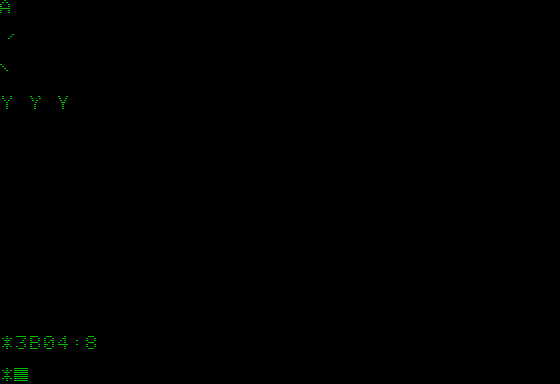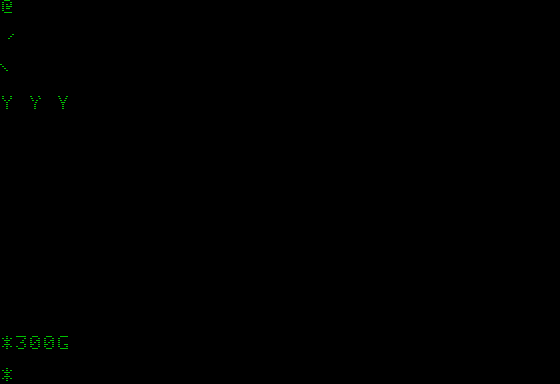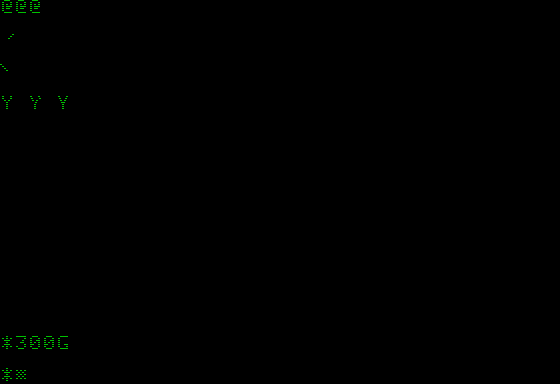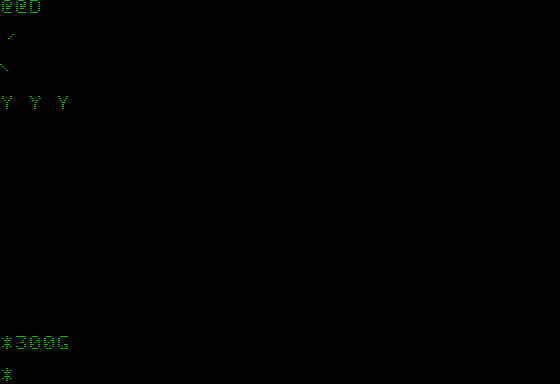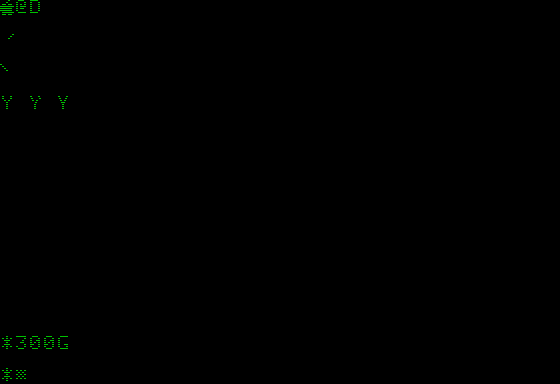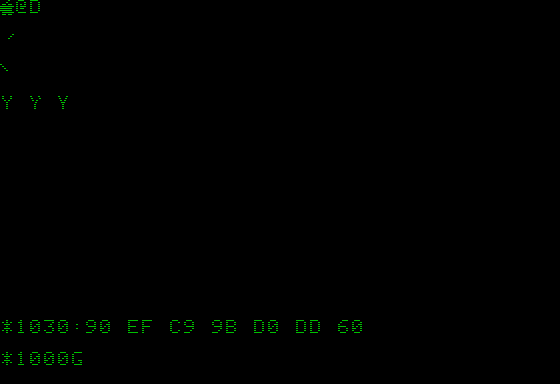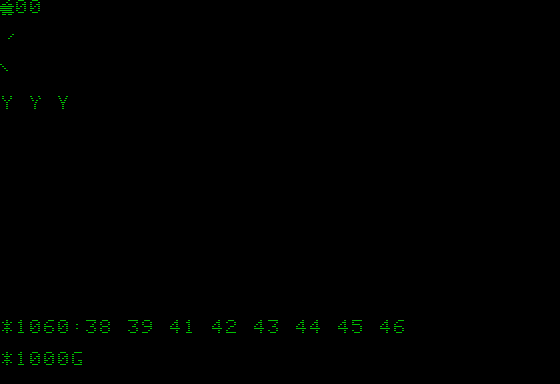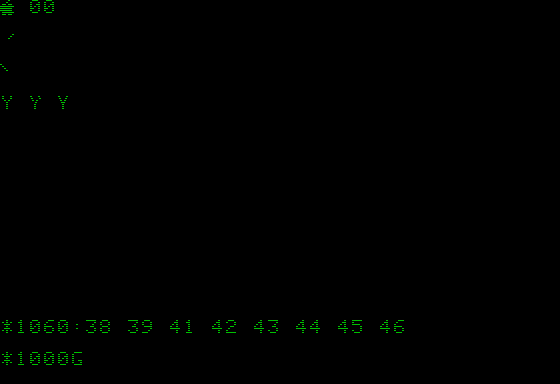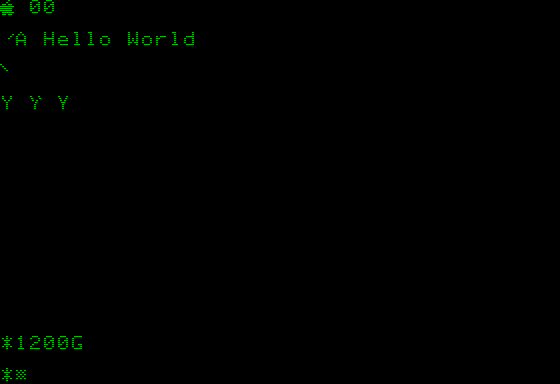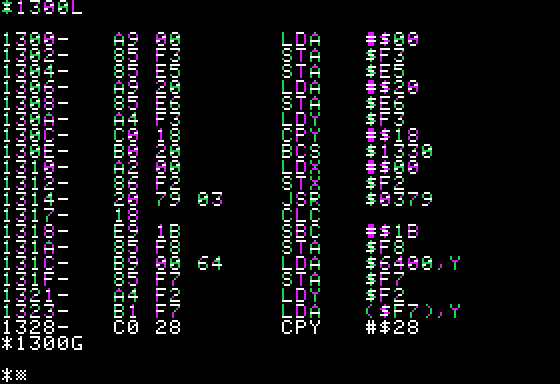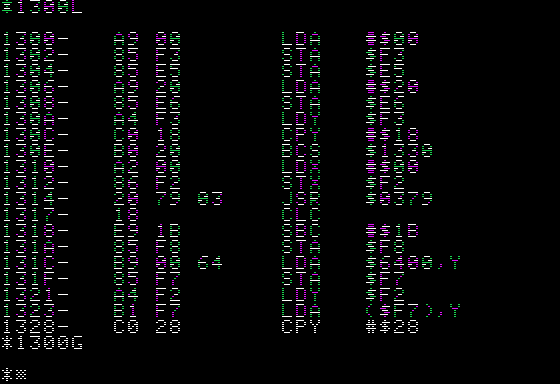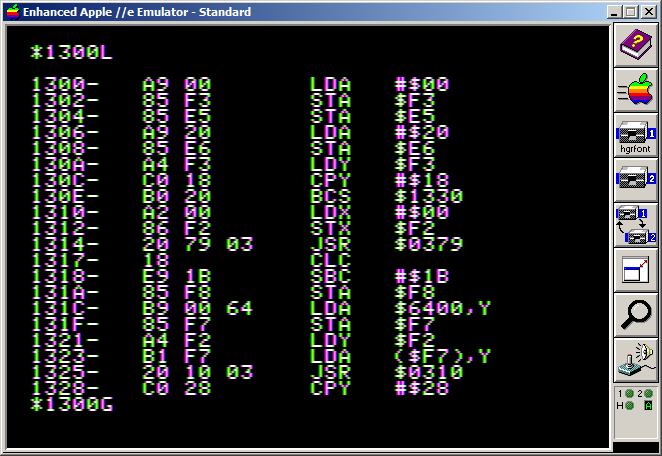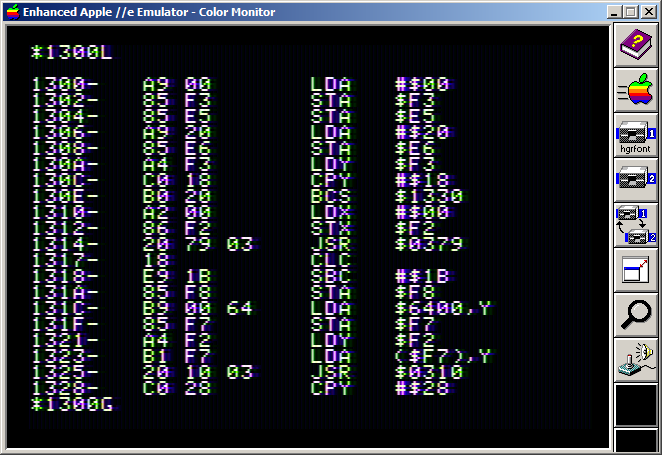| pics | ||
| Apple2eFont7x8.png | ||
| c_2_fontbin.c | ||
| code_0300.bin | ||
| font.bin | ||
| font.h | ||
| hgrtable.bin | ||
| image_2_c.html | ||
| image_2_hex.html | ||
| README.md | ||
| scroll_hgr_up_pixel.html | ||
#Apple ][ HGR Font Tutorial
Revision: 14, Jan 10, 2016.
Table of Contents
- Introduction
- Functions we want & will write
- Hard-Coded: A
- Quirks of the Apple HGR screen
- Non-Linear Memory
- No FONT data in ROM
- HGR bytes are reversed
- Half-pixel shift
- Font Data
- Raw Font Data
- Image to Font Data (Javascript)
- Font -> Screen Memory Trace
- DrawChar version 1
- X Cursor Position
- CursorCol()
- DrawChar() version 2
- DrawChar() version 3
- Character Inspector
- Character Inspector version 2
- Character Inspector version 3
- Y Cursor Position
- Natural Params CursorColRow()
- DrawString()
- Recap
- Copy text screen to HGR
- Exercise 1: ScrollHgrUpLine()
- Exercise 2: ScrollHgrUpPixel()
- Conclusion
- Solution 1: ScrollHgrUpLine()
- Solution 2: ScrollHgrUpPixel()
- References
- Misc. Utilities and Files
- TODO
Introduction
A lot of people in comp.sys.apple2.programmer and other places on the internet have wondered how to "print" text onto the Apple's High Resolution Graphics (HGR) screen. Here's a tutorial on "6502 Font Blitting."
Note: We will prefix hex numbers with $ (or C's notation of 0x). We will prefix binary numbers with %.
Fire up your favorite Apple emulator (cough AppleWin) or real hardware.
If you use:
-
AppleWin press
F2(to reboot),Ctrl-F2to Ctrl-Reset, and then pressF9until you get a Monochrome screen. -
Jace press
Ctrl-Deleteto reset. -
You will also need the Java JRE.
-
Virtual II press
Ctrl-F12to reset.
There are other emulators written in Javascript but they are poor due to 2 reasons:
-
Don't support paste -- you'll be forced to manually enter in the hex code. :-/
-
Don't emulate the half-pixel shift of real hardware at all.
-
Apple 2 js make sure you select:
Options, [x] Green Screen
Functions we want & will write
When we are done we will have 6502 assembly code that implements the equivalent of these C functions names:
void DrawChar();
void DrawCharCol( char c, int col )
void DrawCharColRow( char c, int col, int row );
void SetCursorRow( int row );
void SetCursorColRow( int col, int row );
void SetCursorCol( int col );
void IncCursorCol();
void DrawHexByte( char c );
void DrawString( char *text );
void CopyTextToHGR();
void ScrollHgrUpPixel();
Hard-Coded: A
When you are at the Applesoft ] prompt type (or paste) in the following:
(If you use AppleWin, select the lines, copy, switch back to the emulator, and press Shift-Insert to paste)
HGR
CALL-151
2000:4
2400:A
2800:11
2C00:11
3000:1F
3400:11
3800:11
Voila!
You should see an uppercase A appear in the top left of the HGR screen.
Magic? :-)
Nah, just Computer Science. :-)
The first question you probably have is "How did I know what bytes to use?" We'll get to that in a second.
Quirks of the Apple HGR screen
There are couple of things we need to discuss first. The preceeding example showed that the Apple's HGR screen behaves a little "funky." The Apple's, shall we say, esoteric use of hardware, is one of the reasons us fans love (or hate) it.
Non-Linear Memory
First, we should notice that video memory is non-linear. :-( You'll want to get familiar with the HGR address for the various Y scanlines:
"Understanding the Apple II", page 5-14 has this table HGR Memory-mapped IO:
With all the decimal cruft removed:
| Y | Address | Y | Address | Y | Address | Screen Hole |
|---|---|---|---|---|---|---|
| 0 | $2000 | 64 | $2028 | 128 | $2050 | $2078..$207F |
| 1 | $2400 | 65 | $2428 | 129 | $2450 | $2478..$247F |
| 2 | $2800 | 66 | $2828 | 130 | $2850 | $2878..$287F |
| 3 | $2C00 | 67 | $2C28 | 131 | $2C50 | $2C78..$2C7F |
| 4 | $3000 | 68 | $3028 | 132 | $3050 | $3078..$307F |
| 5 | $3400 | 69 | $3428 | 133 | $3450 | $3478..$347F |
| 6 | $3800 | 70 | $3828 | 134 | $3850 | $3878..$387F |
| 7 | $3C00 | 71 | $3C28 | 135 | $3C50 | $3C78..$3C7F |
| 8 | $2080 | 72 | $20A8 | 136 | $20D0 | $20F8..$20FF |
| 9 | $2480 | 73 | $24A8 | 137 | $24D0 | $24F8..$24FF |
| 10 | $2880 | 74 | $28A8 | 138 | $28D0 | $28F8..$28FF |
| 11 | $2C80 | 75 | $2CA8 | 139 | $2CD0 | $2CF8..$2CFF |
| 12 | $3080 | 76 | $30A8 | 140 | $30D0 | $30F8..$30FF |
| 13 | $3480 | 77 | $34A8 | 141 | $34D0 | $34F8..$34FF |
| 14 | $3880 | 78 | $38A8 | 142 | $38D0 | $38F8..$38FF |
| 15 | $3C80 | 79 | $3CA8 | 143 | $3CD0 | $3CF8..$3CFF |
| 16 | $2100 | 80 | $2128 | 144 | $2150 | $2178..$217F |
| 17 | $2500 | 81 | $2528 | 145 | $2550 | $2578..$257F |
| 18 | $2900 | 82 | $2928 | 146 | $2950 | $2978..$297F |
| 19 | $2D00 | 83 | $2D28 | 147 | $2D50 | $2D78..$2D7F |
| 20 | $3100 | 84 | $3128 | 148 | $3150 | $3178..$317F |
| 21 | $3500 | 85 | $3528 | 149 | $3550 | $3578..$357F |
| 22 | $3900 | 86 | $3928 | 150 | $3950 | $3978..$397F |
| 23 | $3D00 | 87 | $3D28 | 151 | $3D50 | $3D78..$3D7F |
| 24 | $2180 | 88 | $21A8 | 152 | $21D0 | $21F8..$21FF |
| 25 | $2580 | 89 | $25A8 | 153 | $25D0 | $25F8..$25FF |
| 26 | $2980 | 90 | $29A8 | 154 | $29D0 | $29F8..$29FF |
| 27 | $2D80 | 91 | $2DA8 | 155 | $2DD0 | $2DF8..$2DFF |
| 28 | $3180 | 92 | $31A8 | 156 | $31D0 | $31F8..$31FF |
| 29 | $3580 | 93 | $35A8 | 157 | $35D0 | $35F8..$35FF |
| 30 | $3980 | 94 | $39A8 | 158 | $39D0 | $39F8..$39FF |
| 31 | $3D80 | 95 | $3DA8 | 159 | $3DD0 | $3DF8..$3DFF |
| 32 | $2200 | 96 | $2228 | 160 | $2250 | $2278..$227F |
| 33 | $2600 | 97 | $2628 | 161 | $2650 | $2678..$267F |
| 34 | $2A00 | 98 | $2A28 | 162 | $2A50 | $2A78..$2A7F |
| 35 | $2E00 | 99 | $2E28 | 163 | $2E50 | $2E78..$2E7F |
| 36 | $3200 | 100 | $3228 | 164 | $3250 | $3278..$327F |
| 37 | $3600 | 101 | $3628 | 165 | $3650 | $3678..$367F |
| 38 | $3A00 | 102 | $3A28 | 166 | $3A50 | $3A78..$3A7F |
| 39 | $3E00 | 103 | $3E28 | 167 | $3E50 | $3E78..$3E7F |
| 40 | $2280 | 104 | $22A8 | 168 | $22D0 | $22F8..$22FF |
| 41 | $2680 | 105 | $26A8 | 169 | $26D0 | $26F8..$26FF |
| 42 | $2A80 | 106 | $2AA8 | 170 | $2AD0 | $2AF8..$2AFF |
| 43 | $2E80 | 107 | $2EA8 | 171 | $2ED0 | $2EF8..$2EFF |
| 44 | $3280 | 108 | $32A8 | 172 | $32D0 | $32F8..$32FF |
| 45 | $3680 | 109 | $36A8 | 173 | $36D0 | $36F8..$36FF |
| 46 | $3A80 | 110 | $3AA8 | 174 | $3AD0 | $3AF8..$3AFF |
| 47 | $3E80 | 111 | $3EA8 | 175 | $3ED0 | $3EF8..$3EFF |
| 48 | $2300 | 112 | $2328 | 176 | $2350 | $2378..$237F |
| 49 | $2700 | 113 | $2728 | 177 | $2750 | $2778..$277F |
| 50 | $2B00 | 114 | $2B28 | 178 | $2B50 | $2B78..$2B7F |
| 51 | $2F00 | 115 | $2F28 | 179 | $2F50 | $2F78..$2F7F |
| 52 | $3300 | 116 | $3328 | 180 | $3350 | $3378..$337F |
| 53 | $3700 | 117 | $3728 | 181 | $3750 | $3778..$377F |
| 54 | $3B00 | 118 | $3B28 | 182 | $3B50 | $3B78..$3B7F |
| 55 | $3F00 | 119 | $3F28 | 183 | $3F50 | $3F78..$3F7F |
| 56 | $2380 | 120 | $23A8 | 184 | $23D0 | $23F8..$23FF |
| 57 | $2780 | 121 | $27A8 | 185 | $27D0 | $27F8..$27FF |
| 58 | $2B80 | 122 | $2BA8 | 186 | $2BD0 | $2BF8..$2BFF |
| 59 | $2F80 | 123 | $2FA8 | 187 | $2FD0 | $2FF8..$2FFF |
| 60 | $3380 | 124 | $33A8 | 188 | $33D0 | $33F8..$33FF |
| 61 | $3780 | 125 | $37A8 | 189 | $37D0 | $37F8..$37FF |
| 62 | $3B80 | 126 | $3BA8 | 190 | $3BD0 | $3BF8..$3BFF |
| 63 | $3F80 | 127 | $3FA8 | 191 | $3FD0 | $3FF8..$3FFF |
Don't worry if the address pattern makes no sense right now -- we'll reveal that later.
Here's the Javascript source code to generate this table:
```Javascript
function int2pad( n, pad )
{
return (Array( pad+1 ).join(' ') + n).slice(-pad);
}
function word2hex$( w )
{
return "$" + (" " + w.toString(16).toUpperCase()).slice(-4);
}
var hgr = [];
for( var y = 0; y < 193; ++y ) // Intentional 1 scanline too many!
hgr[ y ] = 0x2000 + ((y/64)|0)*0x28 + ((y%8)|0)*0x400 + ((y/8)&7)*0x80;
var text = "", s = " | ";
for( y = 0; y < 64; ++y )
{
var a0 = hgr[ y + 0 ];
var a1 = hgr[ y + 64 ];
var a2 = hgr[ y + 128 ];
text += "| "
+ int2pad( y + 0, 3 ) + s + word2hex$( a0 ) + s
+ int2pad( y + 64, 3 ) + s + word2hex$( a1 ) + s
+ int2pad( y + 128, 3 ) + s + word2hex$( a2 ) + s
+ word2hex$( a2 + 40 ) + ".."
+ word2hex$( a2 + 47 ) + " |\n";
}
console.log( text );
No FONT data in ROM
Second, each glyph in the Apple font is in a 7x8 cell -- the leading line on the bottom is usually blank but we'll store that too so that we have a true "underline" and bottom descender on 'j', 'y', etc.
Unfortunately, the data for the TEXT ROM 25123 hardware chip is not accessible from the 6502. :-/ This means you will need to manually enter in the 8 bytes/character. :-( The good news is that I've already done this so you can copy / paste. :-)
You can find a picture of the Apple ][ ROM text font on Page 8-9, diagram 8.4 of "Understanding the Apple ][" https://archive.org/stream/understanding_the_apple_ii#page/n203/mode/2up
We're actually going to use the Apple //e ROM text font since it has lower case and the famous "Mouse Text" glyphs.
HGR bytes are reversed
Third, the video scanner for HGR mode scans bits in reverse. :-/ This means that we need to "flip" the bits in a byte if we want it to appear properly. Not hard, just inconvenient. We'll store the pre-flipped bits so we don't have to do this at run-time. :-)
For example, If we want these 4 scan-lines of \:
X___
_X__
__X_
___X_
You would normally encode the pixels in binary as:
%1000_0000 = $80
%0100_0000 = $40
%0010_0000 = $20
%0001_0000 = $10
And if we tried entering in:
2100:80
2500:40
2900:20
2D00:10
We would only get:
- 3 scanlines instead of the expected 4 (see the next point), and
- the image would be flipped along the left-right (X axis) like this:
/
On the Apple we need to flip each byte:
%0000_0001 = $01
%0000_0010 = $02
%0000_0100 = $04
%0000_1000 = $08
Enter in:
2200:1
2600:2
2A00:4
2E00:8
And we see the correct: \
Half-pixel shift
Fourth, we mentioned above that when we entered in $80 that the Apple didn't display any pixels for this byte. This is because the Apple uses the high-bit as a flag to shift that group of 7 pixels over HALF a pixel. (Yes, half a pixel.) This means the monochrome effective resolution is a pseudo 560x192. We can't individually access every 560 pixels, only part of them so it is not a "true" 560 resolution. :-( What this means in practice is that we can use this half-pixel shift / byte to get very smooth slopes for Y, etc. :-)
For example this will give us a "sharp" Y:
2300:22
2700:22
2B00:14
2F00:8
3300:8
3700:8
3B00:8
If we change the 2nd and 4th scan line to use this half-pixel shift we can't just set the high bit as we won't get quite the correct image:
Enter in:
2302:22
2702:A2 ;
2B02:14
2F02:88 ;
3302:8
3702:8
3B02:8
We actually also need to moving the left-edge pixel over by 1 so it appears in the correct location when shifted:
2304:22
2704:92 ;
2B04:14
2F04:8C ;
3304:8
3704:8
3B04:8
Ah-ha! We've got a "smooth" Y.
Note: The emulators Virtual ][ and Apple2js are broken emulators. They do not emulate the half-pixel shift of real hardware at all. This is another reason we won't worry about it for now.
We're going to ignore the half-pixel shift since it is easy to touch up the font data later if we wish.
At the beginning we said to view the HGR screen in monochrome. Notice how the extra colors make the Hi-Res text much harder to read. If you are running on real hardware the Apple Color Composite Monitor had a push-button on the front to toggle the screen between color and monochrome. Now we know why!
Font Data
Alrighty then, let's get the font data!
Here is a picture of the Apple //e character set:
If we wanted only uppercase ASCII we could get away with 64 glyphs:
64 glyphs * 8 bytes/glyph = 512 bytes.
Since the font data chews up memory anyways we'll "splurge" and use the full 128 ASCII glyphs:
128 glyphs * 8 bytes/glyph = 1024 bytes = 1K of data.
Ouch! We're using 1K of our precious 64K. Now we know why all those font glyphs was in a ROM chip.
Raw Font Data
I've saved you the trouble of converting all the pixels to hex. You may want to mute your sound since the Apple will beep at the semi-colon "comments".
Enter in (or download Raw Binary Font and with AppleWin press F7, type bload font.bin,6000, press F7):
6000:10 08 36 7F 3F 3F 7E 36 ; ^@
6008:10 08 36 41 21 21 4A 36 ; ^A
6010:00 00 02 06 0E 1E 36 42 ; ^B
6018:7F 22 14 08 08 14 2A 7F ; ^C
6020:00 40 20 11 0A 04 04 00 ; ^D
6028:7F 3F 5F 6C 75 7B 7B 7F ; ^E
6030:70 60 7E 31 79 30 3F 02 ; ^F
6038:00 18 07 00 07 0C 08 70 ; ^G
6040:08 04 02 7F 02 04 08 00 ; ^H
6048:00 00 00 00 00 00 00 2A ; ^I
6050:08 08 08 08 49 2A 1C 08 ; ^J
6058:08 1C 2A 49 08 08 08 08 ; ^K
6060:7F 00 00 00 00 00 00 00 ; ^L
6068:40 40 40 44 46 7F 06 04 ; ^M
6070:3F 3F 3F 3F 3F 3F 3F 3F ; ^N
6078:13 18 1C 7E 1C 18 10 6F ; ^O
6080:64 0C 1C 3F 1C 0C 04 7B ; ^P
6088:40 48 08 7F 3E 1C 48 40 ; ^Q
6090:40 48 1C 3E 7E 08 48 40 ; ^R
6098:00 00 00 7F 00 00 00 00 ; ^S
60A0:01 01 01 01 01 01 01 7F ; ^T
60A8:08 10 20 7F 20 10 08 00 ; ^U
60B0:2A 55 2A 55 2A 55 2A 55 ; ^V
60B8:55 2A 55 2A 55 2A 55 2A ; ^W
60C0:00 3E 41 01 01 01 7F 00 ; ^X
60C8:00 00 3F 40 40 40 7F 00 ; ^Y
60D0:40 40 40 40 40 40 40 40 ; ^Z
60D8:08 1C 3E 7F 3E 1C 08 00 ; ^[
60E0:7F 00 00 00 00 00 00 7F ; ^\
60E8:14 14 77 00 77 14 14 00 ; ^]
60F0:7F 40 40 4C 4C 40 40 7F ; ^^
60F8:01 01 01 01 01 01 01 01 ; ^_
6100:00 00 00 00 00 00 00 00 ;
6108:08 08 08 08 08 00 08 00 ; !
6110:14 14 14 00 00 00 00 00 ; "
6118:14 14 3E 14 3E 14 14 00 ; #
6120:08 3C 0A 1C 28 1E 08 00 ; $
6128:06 26 10 08 04 32 30 00 ; %
6130:04 0A 0A 04 2A 12 2C 00 ; &
6138:08 08 08 00 00 00 00 00 ; '
6140:08 04 02 02 02 04 08 00 ; (
6148:08 10 20 20 20 10 08 00 ; )
6150:08 2A 1C 08 1C 2A 08 00 ; *
6158:00 08 08 3E 08 08 00 00 ; +
6160:00 00 00 00 08 08 04 00 ; ,
6168:00 00 00 3E 00 00 00 00 ; -
6170:00 00 00 00 00 00 08 00 ; .
6178:00 20 10 08 04 02 00 00 ; /
6180:1C 22 32 2A 26 22 1C 00 ; 0
6188:08 0C 08 08 08 08 1C 00 ; 1
6190:1C 22 20 18 04 02 3E 00 ; 2
6198:3E 20 10 18 20 22 1C 00 ; 3
61A0:10 18 14 12 3E 10 10 00 ; 4
61A8:3E 02 1E 20 20 22 1C 00 ; 5
61B0:38 04 02 1E 22 22 1C 00 ; 6
61B8:3E 20 10 08 04 04 04 00 ; 7
61C0:1C 22 22 1C 22 22 1C 00 ; 8
61C8:1C 22 22 3C 20 10 0E 00 ; 9
61D0:00 00 08 00 08 00 00 00 ; :
61D8:00 00 08 00 08 08 04 00 ; ;
61E0:10 08 04 02 04 08 10 00 ; <
61E8:00 00 3E 00 3E 00 00 00 ; =
61F0:04 08 10 20 10 08 04 00 ; >
61F8:1C 22 10 08 08 00 08 00 ; ?
6200:1C 22 2A 3A 1A 02 3C 00 ; @
6208:08 14 22 22 3E 22 22 00 ; A
6210:1E 22 22 1E 22 22 1E 00 ; B
6218:1C 22 02 02 02 22 1C 00 ; C
6220:1E 22 22 22 22 22 1E 00 ; D
6228:3E 02 02 1E 02 02 3E 00 ; E
6230:3E 02 02 1E 02 02 02 00 ; F
6238:3C 02 02 02 32 22 3C 00 ; G
6240:22 22 22 3E 22 22 22 00 ; H
6248:1C 08 08 08 08 08 1C 00 ; I
6250:20 20 20 20 20 22 1C 00 ; J
6258:22 12 0A 06 0A 12 22 00 ; K
6260:02 02 02 02 02 02 3E 00 ; L
6268:22 36 2A 2A 22 22 22 00 ; M
6270:22 22 26 2A 32 22 22 00 ; N
6278:1C 22 22 22 22 22 1C 00 ; O
6280:1E 22 22 1E 02 02 02 00 ; P
6288:1C 22 22 22 2A 12 2C 00 ; Q
6290:1E 22 22 1E 0A 12 22 00 ; R
6298:1C 22 02 1C 20 22 1C 00 ; S
62A0:3E 08 08 08 08 08 08 00 ; T
62A8:22 22 22 22 22 22 1C 00 ; U
62B0:22 22 22 22 22 14 08 00 ; V
62B8:22 22 22 2A 2A 36 22 00 ; W
62C0:22 22 14 08 14 22 22 00 ; X
62C8:22 22 14 08 08 08 08 00 ; Y
62D0:3E 20 10 08 04 02 3E 00 ; Z
62D8:3E 06 06 06 06 06 3E 00 ; [
62E0:00 02 04 08 10 20 00 00 ; \
62E8:3E 30 30 30 30 30 3E 00 ; ]
62F0:00 00 08 14 22 00 00 00 ; ^
62F8:00 00 00 00 00 00 00 7F ; _
6300:04 08 10 00 00 00 00 00 ; `
6308:00 00 1C 20 3C 22 3C 00 ; a
6310:02 02 1E 22 22 22 1E 00 ; b
6318:00 00 3C 02 02 02 3C 00 ; c
6320:20 20 3C 22 22 22 3C 00 ; d
6328:00 00 1C 22 3E 02 3C 00 ; e
6330:18 24 04 1E 04 04 04 00 ; f
6338:00 00 1C 22 22 3C 20 1C ; g
6340:02 02 1E 22 22 22 22 00 ; h
6348:08 00 0C 08 08 08 1C 00 ; i
6350:10 00 18 10 10 10 12 0C ; j
6358:02 02 22 12 0E 12 22 00 ; k
6360:0C 08 08 08 08 08 1C 00 ; l
6368:00 00 36 2A 2A 2A 22 00 ; m
6370:00 00 1E 22 22 22 22 00 ; n
6378:00 00 1C 22 22 22 1C 00 ; o
6380:00 00 1E 22 22 1E 02 02 ; p
6388:00 00 3C 22 22 3C 20 20 ; q
6390:00 00 3A 06 02 02 02 00 ; r
6398:00 00 3C 02 1C 20 1E 00 ; s
63A0:04 04 1E 04 04 24 18 00 ; t
63A8:00 00 22 22 22 32 2C 00 ; u
63B0:00 00 22 22 22 14 08 00 ; v
63B8:00 00 22 22 2A 2A 36 00 ; w
63C0:00 00 22 14 08 14 22 00 ; x
63C8:00 00 22 22 22 3C 20 1C ; y
63D0:00 00 3E 10 08 04 3E 00 ; z
63D8:38 0C 0C 06 0C 0C 38 00 ; {
63E0:08 08 08 08 08 08 08 08 ; |
63E8:0E 18 18 30 18 18 0E 00 ; }
63F0:2C 1A 00 00 00 00 00 00 ; ~
63F8:00 2A 14 2A 14 2A 00 00 ;
Image to Font Data (Javascript)
If you were wondering how this data was generated, you see the great thing about computers is that they can automate all the tedious and boring crap, er, calculations for us. Here's a HTML + Javascript program I wrote to convert the image to HEX:
<!DOCTYPE HTML>
<html>
<head>
<script>
function byte2hex$( byte )
{
return ("0" + byte.toString(16)).toUpperCase().substr(-2)
}
function OnLoad()
{
var image = document.getElementById( "Apple2eFont7x8" );
var canvas = document.createElement( "Canvas" );
var context = canvas.getContext( "2d" );
canvas.width = image.width;
canvas.height = image.height;
context.drawImage( image, 0, 0 );
var CW = 7, CH = 8; // Cell Width Height
var address = 0x6000, pixel, rgba, lines = "";
for( var ty = 0; ty < image.height/CH; ++ty )
{
for( var tx = 0; tx < image.width/CW; ++tx )
{
var text = "";
for( var y = 0; y < CH; ++y )
{
var hex = 0, mask = 0x1;
for( var x = 0; x < CW; ++x, mask <<= 1 )
{
pixel = context.getImageData( tx*CW+x, ty*CH+y, 1, 1 );
rgba = pixel.data;
hex += rgba[0] ? mask : 0; // assume R=G=B
}
text += byte2hex$( hex ) + " ";
}
var c = (16*ty)+tx, d = String.fromCharCode( c );
if (c < 32) d = "^" + String.fromCharCode( c + 0x40 );
text += "; " + d + "\n";
lines += "" + address.toString(16).toUpperCase() + ":" + text;
address += 8;
}
}
console.log( lines );
var pre = document.getElementById( "hexdump" );
pre.innerHTML = lines;
}
</script>
</head>
<body onload="OnLoad()">
<img id="Apple2eFont7x8" src="Apple2eFont7x8.png">
<hr>
<pre id="hexdump"></pre>
</body>
</html>
Note: If you get a retarded Uncaught SecurityError: Failed to execute 'getImageData' on 'CanvasRenderingContext2D': The canvas has been tainted by cross-origin data. with Chrome you need to start it with the command line:
--allow-file-access-from-files
Another solution is to use a web browser that isn't "broken" such as Firefox, etc. when trying to read local files.
Font -> Screen Memory Trace
OK, so now that we have the font data, how do we draw a character "on screen" ?
Remember we need to transfer 8 consecutive bytes (1 byte / scanline) to 8 different scanlines.
Assuming we want to draw the A glyph at the top-left of the screen we would need to transfer bytes from the (source) font glyph memory locations to the (destination) screen memory locations:
($6208) -> $2000
($6209) -> $2400
($620A) -> $2800
($620B) -> $2C00
($620C) -> $3000
($620D) -> $3400
($620E) -> $3800
($620F) -> $3C00
For simplicity, we're going to "quantize" our destination Y so that we render font glyphs only on the start of every 8 rows and every 7 pixel columns. If we then had the starting address we simply could move to the next scan line by successively adding $0400 to our destination screen pointer.
How did I know to use $0400 when going to the next line? One quirk of the HGR screen is that every 8 successive scan lines start this many bytes away. Refer back to the HGR Memory-mapped IO table listed above.
DrawChar() version 1
Before we can start a simple DrawChar(char c) function, we also first need to assign some zero page memory locations for our static and temporary variables:
$E5 Low byte (16-bit address) Pointer to screen destination
$E6 High byte (16-bit Address) Pointer to screen destination
$F5 Low byte (16-bit address) Working pointer to screen byte
$F6 High byte (16-bit address) Working pointer to screen byte
Here's the disassembly of our (hard-coded) DrawChar() program:
; FUNC: DrawChar() = $0300
; NOTES: A, X, Y is destroyed
300: JSR ScreenPtrToTempPtr
303: LDA #00 ; glyph 'c' to draw (not used yet)
305: LDY #00 ; Y = column to draw at (hard-coded)
307: JMP _DrawChar
307 .ORG $0352
352: _DrawChar:
352: LDX #0
354: .1 LDA $6200,X ; A = font[ offset + i ]
357: STA ($F5),Y ; screen[col] = A
359: CLC
35A: LDA $F6
35C: ADC #4
35E: STA $F6
360: INX
361: CPX #8
363: BNE .1
365: RTS
; FUNC: ScreenPtrToTempPtr() = $0366
366: LDA $E5 ; Copy initial screen
368: STA $F5 ; destination pointer
36A: LDA $E6 ; to working pointer
36C: STA $F6
36D: RTS
Enter in:
300:20 66 03 A9 00 A0 00 4C 52 03
352:A2 00 BD 00 62 91
358:F5 18 A5 F6 69 04 85 F6
360:E8 E0 08 D0 EF 60
366:A5 E5 85 F5 A5 E6 85 F6 60
We're almost ready to run this! We just need to initialize one variable -- where to draw the glyph at:
E5:00 20
300G
And with any luck you should see the at sign @ in the top-left.
X Cursor Position
If we wanted to draw in columns 1 and 2 instead of column 0 then we need to set the Y register which controls which "column" we'll draw at.
Enter in:
306:1
300G
306:2
300G
This works because we are using the 6502 Indirect Zero-Page Y addressing mode to store the destination pixels with the STA instruction. Since the Y-register must always be used in this addressing mode we get a column offset "for free." :-)
357: STA ($F5),Y ; screen[col] = A
Here's the C pseudo-code of the assembly code:
char c = '@'; // 0x40;
int col = 0;
char FONT[] = { ... }; // our font data glyphs
char *screen = 0x2000 + col; // destination
char *font = 0x6200; // eventually want: &FONT[ c*8 ]
for( y = 0; y < 8; y++, screen += 0x400 )
*screen = *font++;
CursorCol( col )
Since the Y-register controls the column we can inline this function and have the caller take care of setting the Y-Register before calling DrawChar().
LDY #column
After DrawChar() it is handy if we can advance both:
- the column of the cursor
- the pointer to the screen where the next glyph will be drawn
; FUNC: IncCursorCol() = $0370
; OUTPUT: Y-Register (column) is incremented
; Increment the cursor column and move the destination screen pointer back
; up 8 scan lines previously to what it was when DrawChar() was called.
370:C8 INY
371:18 CLC
372:A5 F6 LDA $F6
374:E9 1F SBC #1F
376:85 F6 STA $F6
378:60 RTS
Enter in:
370:C8 18 A5 F6 E9 1F 85 F6 60
DrawChar() version 2
The glyph to draw is currently hard-coded to $40 (@). The pointer to the start of this glyph is located at:
source = $6000 + ($40*8) = $6000 + $200 = $6200
If we wanted to draw a different glyph, say D we would need to modify the source pointer of the font glyph data.
Recall that our font has this memory layout:
| Char | Index | Address |
|---|---|---|
| ^@ | $00 | $6000 |
| ^A | $01 | $6008 |
| ^B | $02 | $6010 |
| ^C | $03 | $6018 |
| : | : | |
| Spc | $20 | $6100 |
| ! | $21 | $6108 |
| : | : | |
| 0 | $30 | $6180 |
| 1 | $31 | $6188 |
| 2 | $32 | $6190 |
| 3 | $33 | $6198 |
| : | : | |
| ? | $3F | $61F8 |
| @ | $40 | $6200 |
| A | $41 | $6208 |
| B | $42 | $6210 |
| C | $43 | $6218 |
| D | $44 | $6220 |
| : | : | : |
| _ | $5F | $62F8 |
The 6502 stores and loads 16-bit addresses in little-endian format so for glyph D, we need to store the bytes of the address $6220 in reverse order.
Enter in:
355:20 62
And to draw the new glyph, enter in:
300G
We should see the last character of the 3 @@@ change to D.
DrawChar() version 3
Let's remove the hard-coded printing of the glyph and use the character data we really want to draw. This means we need to "fix-up" the temporary source pointer to the font glyph data. Since we have 8 bytes/glyph we need to manually calculate the array offset.
Our array offset for the source glyph data is:
address = $6000 + (c * 8)
Some C pseudo-code would be:
char c = 'D'; // 0x44
int offset = c * 8;
int address = 0x6000 + offset;
Since we are dealing with a 16-bit address offset it is simpler to break this down into a low-byte and high-byte calculation for the 6502 since it can't natively do 16-bit offsets. Every 32 characters we need to offset 256 bytes.
int AddressHi = 0x60 + (c / 32)
But since the 6502 doesn't have a division instruction we need to use bit-shifts instead. The calculation c / 32 is the same as c >> 5.
char c = 'D'; // 0x44
char *Font = 0x6000;
int FontHi = (Font >> 8) & 0xFF;
int FontLo = (Font >> 0) & 0xFF;
int AddressHi = FontHi + ((c >> 5) & 0x07);
int AddressLo = FontLo + ((c << 3) & 0xF8);
A naive glyph/32 calculation would be to use 5 shift right bit-shifts:
68 PLA ; pop c = %PQRSTUVW to draw
29 60 AND #60 ; = %PQR00000 S=0, Optimization: implicit CLC
4A LSR ; c / 2 = %0PQRSTUV
4A LSR ; c / 4 = %00PQRSTU
4A LSR ; c / 8 = %000PQRST
4A LSR ; c / 16 = %0000PQRS
4A LSR ; c / 32 = %00000PQR
However we can save one instruction (and 2 cycles) if we optimize c/32 to use the counterintuitive 6502's ROL instruction -- which only requires 4 instructions instead:
68 PLA ; pop c = %PQRSTUVW to draw
29 60 AND #C0 ; = %PQR00000 S=0, Optimization: implicit CLC
2A ROL ; = %QR000000 C=P
2A ROL ; = %R000000P C=Q
2A ROL ; = %000000PQ C=R
2A ROL ; c / 32 = %00000PQR C=0
Our prefix code to setup the source address becomes:
; FUNC: DrawCharCol( c, col ) = $03BB
; FUNC: DrawCharCol( c, col ) = $03BB
; PARAM: A = glyph to draw
; PARAM: Y = column to draw at; $0 .. $27 (Columns 0 .. 39) (not modified)
; NOTES: X is destroyed
33B:48 PHA ; push c = %PQRSTUVW to draw
33C:29 1F AND #1F ; = %000STUVW R=0, Optimization: implicit CLC
33E:0A ASL ; c * 2 %00STUVW0
33F:0A ASL ; c * 4 %0STUVW00
340:0A ASL ; c * 8 %STUVW000
341:69 00 ADC #00 ; += FontLo; Carry = 0 since R=0 from above
343:8D 55 03 STA $355 ; AddressLo = FontLo + (c*8)
346:68 PLA ; pop c = %PQRSTUVW to draw
347:29 60 AND #60 ; = %PQR00000 S=0, Optimization: implicit CLC
349:2A ROL ; = %QR000000 C=P
34A:2A ROL ; = %R000000P C=Q
34B:2A ROL ; = %000000PQ C=R
34C:2A ROL ; c / 32 = %00000PQR C=0 and one more to get R
34D:69 60 ADC #60 ; += FontHi; Carry = 0 since S=0 from above
34F:8D 56 03 STA $356 ; AddressHi = FontHi + (c/32)
Recall we'll re-use our existing font drawing code at $0352:
352:A2 00 LDX #0
354:BD 00 00 LDA $0000,X ; A = font[ offset + i ]
357:91 F5 STA ($F5),Y ; screen[col] = A
359:18 CLC
35A:A5 F6 LDA $F6
35C:69 04 ADC #4 ; screen += 0x400
35E:85 F6 STA $F6
360:E8 INX
361:E0 08 CPX #8
363:D0 EF BNE $304
365:60 RTS
We just need to touch up our entry point from $0352 ScreenPtrToTempPtr() to $033B DrawCharCol():
307:4C 3B 03 JMP $033B ; DrawCharCol()
Enter in:
300:20 66 03 A9 00 A0 00 4C 3B 03
33B:48 29 1F 0A 0A
340:0A 69 00 8D 55 03 68 29
348:60 2A 2A 2A 2A 69 60 8D
350:56 03
300G
We should now see an closed apple glyph!
To change which glyph is printed:
304:41
300G
And we should see an A printed.
We now have the ability to print any of the 128 ASCII characters!
Character Inspector
Let's verify this by writing a character inspector. We'll use the arrow keys to select the glyph and ESC to exit.
; FUNC: DemoCharInspect() = $1000
1000:A9 00 LDA #0 ; c=0
1002:85 FE STA $FE ; save which glyph to draw
1004:A9 00 .1 LDA #0 ; screen = 0x2000
1006:85 F5 STA $F5 ;
1008:A9 20 LDA #20 ;
100A:85 F6 STA $F6 ;
100C:A5 FE LDA $FE ; A = glyph c
100E:A0 00 LDY #00 ; Y = col
1010:20 3B 03 JSR $033B ; DrawCharCol()
1013:AD 00 C0 .2 LDA $C000 ; read A=key
1016:10 FB BMI .2 ; no key?
1018:8D 10 C0 STA $C010 ; debounce key
101B:C9 88 CMP #88 ; key == <-- ?
101D:D0 0A BNE .4 ;
101F:C6 FE DEC $FE ; yes, --c
1021:A5 FE .3 LDA $FE ; c &= 0x7F
1023:29 7F AND #7F
1025:85 FE STA $FE
1027:10 DB BPL .1 ; always branch, draw prev char
1029:C9 95 .4 CMP #95 ; key == --> ?
102B:D0 05 BNE .5 ;
102D:E6 FE INC $FE ; yes, ++c
102F:18 CLC
1030:90 EF BCC .3 ; always branch, draw prev char
1032:C9 9B .5 CMP #9B ; key == ESC ?
1034:D0 DD BNE .2 ;
1036:60 RTS ; yes, exit
Enter in this code:
1000:A9 00 85 FE A9 00 85 F5
1008:A9 20 85 F6 A5 FE A0 00
1010:20 3B 03 AD 00 C0 10 FB
1018:8D 10 C0 C9 88 D0 0A C6
1020:FE A5 FE 29 7F 85 FE 10
1028:DB C9 95 D0 05 E6 FE 18
1030:90 EF C9 9B D0 DD 60
1000G
We now have an ASCII char inspector!
Character Inspector version 2
Let's fix it up to print the hex value of the current character we are inspecting:
1010:20 37 10 JSR $1037
1037:48 PHA ; save c
1038:20 3B 03 JSR $033B ; DrawCharCol()
103B:68 PLA ; restore c so we can print it in hex
; FUNC: DrawHexByte( c ) = $103C
; PARAM: A = byte to print in hex
103C:48 PHA ; save low nibble
103D:6A ROR ; shift high nibble
103E:6A ROR ; to low nibble
103F:6A ROR
1040:6A ROR
1041:20 48 10 JSR DrawHexNib ; print high nib in hex
1044:68 PLA ; pop low nibble
1045:4C 48 10 JMP DrawHexNib ; print low nib in hex
; FUNC: DrawHexNib() = $1048
; PARAM: A = nibble to print as hex char
1048:29 0F AND #F ; base 16
104A:AA TAX ;
104B:20 66 03 JSR $0366 ; update dest screen pointer
104E:BD 58 10 LDA $1058,X ; nibble to ASCII
1051:C8 INY ; IncCursorCol()
1052:20 3B 03 JSR $033B ; DrawCharCol()
1055:60 RTS
1058:30 31 32 33 ASC "0123456789ABCDEF"
105C:34 35 36 37
1060:38 39 41 42
1064:43 44 45 46
Enter in:
1010:20 37 10
1037:48
1038:20 3B 03 68 48 6A 6A 6A
1040:6A 20 48 10 68 4C 48 10
1048:29 0F AA 20 66 03 BD 58
1050:10 C8 20 3B 03 60
1058:30 31 32 33 34 35 36 37
1060:38 39 41 42 43 44 45 46
1000G
And now we have our own DrawHexByte() function.
Character Inspector version 3
Let's use IncCursorCol() to automatically advance the cusor. We'll also add a space after the character but before the hex value to improve readability of the output.
; FUNC: PrintChar() = $0310
; PARAM: A = glyph to draw
; PARAM: Y = column to draw at; $0 .. $27 (Columns 0 .. 39) (not modified)
; INPUT : $F5,$F6 pointer to the destination screen scanline
; Must start at every 8 scanlines.
; OUTPUT: The Y-Register (cursor column) is automatically incremented.
310:20 3B 03 JSR DrawCharCol
313:4C 70 03 JMP IncCursorCol
1010:20 37 10 JSR $1037
1037:48 PHA ; save c
1038:20 10 03 JSR PrintChar ;
103B:A9 20 LDA ' ' ; Draw whitespace
103D:20 10 03 JSR PrintChar ;
1040:68 PLA ; restore c so we can print it in hex
; FUNC: DrawHexByte( c )
; PARAM: A = byte to print in hex
1041:48 PHA ; save low nibble
1042:6A ROR ; shift high nibble
1043:6A ROR ; to low nibble
1044:6A ROR
1045:6A ROR
1046:20 4D 10 JSR DrawHexNib ; print high nib in hex
1049:68 PLA ; pop low nibble
104A:4C 4D 10 JMP DrawHexNib ; print low nib in hex
; FUNC: $1048 = DrawHexNib()
; PARAM: A = nibble to print as hex char
104D:29 0F AND #F ; base 16
104F:AA TAX ;
1050:BD 58 10 LDA $1058,X ; nibble to ASCII
1053:4C 10 03 JMP PrintChar ;
1058:30 31 32 33 ASC "0123456789ABCDEF"
105C:34 35 36 37
1060:38 39 41 42
1064:43 44 45 46
Enter in:
310:20 3B 03 4C 70 03
1010:20 37 10
1037:48
1038:20 10 03 A9 20 20 10 03
1040:68 48 6A 6A 6A 6A 20 4D
1048:10 68 4C 4D 10 29 0F AA
1050:BD 58 10 4C 10 03
1058:30 31 32 33 34 35 36 37
1060:38 39 41 42 43 44 45 46
1000G
Y Cursor Position
Right now the line we "print" to is hard-coded since we are using a screen address of $2000 with the pointer at $E5, $E6.
We're going to digress slightly before we fix this.
The secret to getting high speed graphics rendering on the Apple is to use a look-up table. We're going to have a 16-bit address lookup table for Y=0, Y=8, Y=16, .. Y = 184
The HGR screen address is broken up a triad. Every 64 scan lines the offset change by $28.
| Y | Address | Hi | Lo |
|---|---|---|---|
| 0 | $2000 | $20 | $00 |
| 8 | $2080 | $20 | $80 |
| 16 | $2100 | $21 | $00 |
| 24 | $2180 | $21 | $80 |
| 32 | $2200 | $22 | $00 |
| 40 | $2280 | $22 | $80 |
| 48 | $2300 | $23 | $00 |
| 56 | $2380 | $23 | $80 |
| - | ----- | - | - |
| 64 | $2028 | $20 | $28 |
| 72 | $20A8 | $20 | $A8 |
| 80 | $2128 | $21 | $28 |
| 88 | $21A8 | $21 | $A8 |
| 96 | $2228 | $22 | $28 |
| 104 | $22A8 | $22 | $A8 |
| 112 | $2328 | $23 | $28 |
| 120 | $23A8 | $23 | $A8 |
| - | ----- | - | - |
| 128 | $2050 | $20 | $50 |
| 136 | $20D0 | $20 | $D0 |
| 144 | $2150 | $21 | $50 |
| 152 | $21D0 | $21 | $D0 |
| 160 | $2250 | $22 | $50 |
| 168 | $22D0 | $22 | $D0 |
| 176 | $2350 | $23 | $50 |
| 184 | $23D0 | $23 | $D0 |
We'll split the table of addresses into Low and High bytes for easier access. We'll also subtract off the hard-coded graphics page 1 high byte = $20 and instead use relative offsets to make it work with either graphics page 1 or 2.
This is our mini HGR Y Address look-up table. "Funny" that it has 24 entries -- the same height as our text screen. :-)
Enter these bytes (or save hgrtable.bin and bload hgrtable.bin,6400):
Our HgrLo table:
6400:00 80 00 80 00 80 00 80
6408:28 A8 28 A8 28 A8 28 A8
6410:50 D0 50 D0 50 D0 50 D0
Our HgrHi table:
6418:00 00 01 01 02 02 03 03
6420:00 00 01 01 02 02 03 03
6428:00 00 01 01 02 02 03 03
To save this AppleWin press F7, at the debugger console bsave "hgrtable.bin",6400:642F, press F7.
To select which row to draw at we'll pass that in the X register to our DrawCharColRow() routine:
; FUNC: DrawCharColRow() = $0320
; PARAM: A = glyph to draw
; PARAM: Y = column to draw at; $0 .. $27 (Columns 0 .. 39) (not modified)
; PARAM: X = row to draw at; $0 .. $17 (Rows 0 .. 23) (destroyed)
320:48 PHA
321:20 28 03 JSR CursorRow()
324:68 PLA
325:4C 3B 03 JMP DrawCharCol()
; FUNC: CursorRow( row ) = $0328
; PARAM: X = row to draw at; $0 .. $17 (Rows 0 .. 23) (not modified)
; INPUT : $E5,$E6 initial pointer to the destination screen scanline
; Note: Must start at every 8 scanlines.
; OUTPUT: $F5,$F5 working pointer to the destination screen scanline
328:BD 00 64 LDA $6400,X ; HgrLo[ row ]
32B:18 CLC
32C:65 E5 ADC $E5
32E:85 F5 STA $F5
330:BD 18 64 LDA $6418,X ; HgrHi[ row ]
333:18 CLC
334:65 E6 ADC $E6
336:85 F6 STA $F6
338:60 RTS
Enter in:
320:48 20 28 03 68 4C 3B 03
328:BD 00 64 18 65 E5 85 F5
330:BD 18 64 18 65 E6 85 F6
338:60
Now we can print a char at any location:
1100:A9 41 ; A-register = char
1102:A0 01 ; Y-register = col 1 (2nd column)
1104:A2 02 ; X-register = row 2 (3rd row)
1106:4C 20 03 ; DrawCharColRow( c, col )
Enter in:
1100:A9 41 A0 01 A2 02 4C 20 03
1100G
Natural Params CursorColRow()
Unfortunately, our usage of the X and Y registers are not intuitive. This is due to the limited addressing modes of the 6502. :-/ If the 6502 had a symmetrical indirect zero-page X addressing mode:
LDA ($ZP),X
We could map the X-register to the natural column (x-axis), and the Y-register to the natural row (y-axis). Alas, we're stuck with the X=row and Y=col unless we wanted to add extra code to "swap" the two.
; FUNC: CursorColRow() = $0379
; PARAM: Y = col
; PARAM: X = row
379:20 28 03 JSR CursorRow
37C:18 CLC
37D:98 TYA
37E:65 F5 ADC $F5
381:85 F5 STA $F5
383:60
Enter:
379:20 28 03 18 98 65 F5 85 F5 60
Or are we stuck? Since we're using a function to calculate the destination address let's fix the order.
We'll need to change the X offset in CursorRow() to Y;
; FUNC: CursorRow2( row ) = $033B
; PARAM: Y = row
; NOTES: Version 2 !
328:B9 00 64 LDA $6400,Y ; changed from: ,X
32B:18 CLC
32C:65 E5 ADC $E5
32E:85 F5 STA $F5
330:B9 18 64 LDA $6418,Y ; changed from: ,X
333:18 CLC
334:65 E6 ADC $E6
336:85 F6 STA $F6
338:60 RTS
And change the low byte to add X instead:
; FUNC: CursorColRow2( col, row ) = $0379
; PARAM: X = col
; PARAM: Y = row
; NOTES: Version 2 !
379:20 28 03 JSR CursorRow
37C:18 CLC
37D:88 TXA ; changed from: TYA
37E:65 F5 ADC $F5
381:85 F5 STA $F5
383:60
This is a little clunky but it is progress. Let's write the new CursorColRow() version with the CursorRow() inlined so we don't have to use a JSR.
; FUNC: CursorColRow3( col, row ) = $0379
; PARAM: X = column to draw at; $0 .. $27 (Columns 0 .. 39) (not modified)
; PARAM: Y = row to draw at; $0 .. $17 (Rows 0 .. 23) (not modified)
; NOTES: Version 3! X and Y is swapped from earlier version!
; [$F5] = HgrLo[ Y ] + [$E5] + X
379:86 F5 STX $F5
37B:B9 00 64 LDA $6400,Y ; HgrLo[ row ]
37E:18 CLC
37F:65 E5 ADC $E5
381:65 F5 ADC $F5
383:85 F5 STA $F5
385:B9 18 64 LDA $6418,Y ; HgrHi[ row ]
388:18 CLC
389:65 E6 ADC $E6
38B:85 F6 STA $F6
38D:60 RTS
Enter in:
379: 86 F5 B9 00 64 18 65
380:E5 65 F5 85 F5 B9 18 64
388:18 65 E6 85 F6 60
DrawString()
Now that we have the basic print char working lets extend it to print a C-style string (one that is zero terminated.)
; FUNC: DrawString( *text ) = $038E
; PARAM: X = High byte of string address
; PARAM: Y = Low byte of string address
38E:84 F0 STY $F0
390:86 F1 STX $F1
392:A0 00 LDY #0
394:B1 F0 .1 LDA ($F0),Y
396:F0 07 BEQ .2 ; null byte? Done
398:20 10 03 JSR PrintChar
39B:C0 28 CPY 40 ; col < 40?
39D:90 F5 BCC .1
39F:60 .2 RTS
And our example to verify that it works:
; FUNC: DemoDrawString()
1200:A2 03 LDX #3 ; col = 3
1202:A0 02 LDY #2 ; row = 2
1204:20 79 03 JSR CursorColRow3
1207:A2 12 LDX >.3 ; High
1209:A0 0E LDY <.3 ; Low
120B:4C 8E 03 JMP DrawString
120E: .3 ASC "Hello World",0
120E:48 65 6C 6C 6F 20 57 6F 72 6C 64 00
Enter:
38E:84 F0 86 F1 A0 00 B1 F0
396:F0 07 20 10 03 C0 28 90 F5 60
1200:A2 03 A0 02 20 79 03
1207:A2 12 A0 0E 4C 8E 03
120E:48 65 6C 6C 6F 20 57 6F 72 6C 64 00
1200G
Note: An easy way to get the hex bytes for a string is to use this tiny Javascript snippet to convert a text string to hex:
var txt = "Hello World";
for( var i=0; i < txt.length; ++i )
console.log( txt.charCodeAt(i).toString(16) );
Recap
Here are all the routines we've entered in so far:
300:20 66 03 A9 00 A0 00 4C 3B 03
310:20 3B 03 4C 70 03
320:48 20 28 03 68 4C 3B 03
328:BD 00 64 18 65 E5 85 F5
330:BD 18 64 18 65 E6 85 F6
338:60 EA EA 48 29 1F 0A 0A
340:0A 69 00 8D 55 03 68 29
348:60 2A 2A 2A 2A 69 60 8D
350:56 03 A2 00 BD 00 62 91
358:F5 18 A5 F6 69 04 85 F6
360:E8 E0 08 D0 EF 60 A5 E5
368:85 F5 A5 E6 85 F6 60
370:C8 18 A5 F6 E9 1F 85 F6
378:60 86 F5 B9 00 64 18 65
380:E5 65 F5 85 F5 B9 18 64
388:18 65 E6 85 F6 60 84 F0
390:86 F1 A0 00 B1 F0 F0 07
398:20 10 03 C0 28 90 F5 60
We also have a mini HGR Y address lookup table:
6400:00 80 00 80 00 80 00 80
6408:28 A8 28 A8 28 A8 28 A8
6410:50 D0 50 D0 50 D0 50 D0
6418:00 00 01 01 02 02 03 03
6420:00 00 01 01 02 02 03 03
6428:00 00 01 01 02 02 03 03
What's left? Quite a few things actually:
- Copy the 40-Column text screen to HGR
- Scroll the HGR screen up by 1 pixel
- Copy the 80-Column text screen to DHGR (Double High Resolution)
- Hook into the COUT so all text appears onto the HGR or DHGR screen
Let's implement those first two.
Copy text screen to HGR
For our final trick we are going to copy the characters off the text screen onto the HGR screen. More magic? Nah, just bit-shuffling.
The text screen, like the HGR screen, is also non-linear, and also broken up into a triad:
| Row | Text Addrress | HGR Address |
|---|---|---|
| 0 | $400 | $2000 |
| 1 | $480 | $2080 |
| 2 | $500 | $2100 |
| 3 | $580 | $2180 |
| 4 | $600 | $2200 |
| 5 | $600 | $2280 |
| 6 | $700 | $2300 |
| 7 | $780 | $2380 |
| - | ---- | ----- |
| 8 | $428 | $2028 |
| 9 | $4A8 | $20A8 |
| 10 | $528 | $2128 |
| 11 | $5A8 | $21A8 |
| 12 | $628 | $2228 |
| 13 | $6A8 | $22A8 |
| 14 | $728 | $2328 |
| 15 | $7A8 | $23A8 |
| - | ---- | ----- |
| 16 | $450 | $2050 |
| 17 | $4D0 | $20D0 |
| 18 | $550 | $2150 |
| 19 | $5D0 | $21D0 |
| 20 | $650 | $2250 |
| 21 | $6D0 | $22D0 |
| 22 | $750 | $2350 |
| 23 | $7D0 | $23D0 |
While the Apple's memory layout seems esoteric it has beautiful symmetry. For any given text row notice that:
- the low byte of the text address is the same low byte of the HGR address
- the high byte of the text address is 0x1C less then the high byte of the HGR address
Technically, to convert the HGR high byte address to a Text high byte address, we only need to map these 4 high bytes:
| HGR High Byte | Text High Byte |
|---|---|
| $20 = %0010_0000 | $4 = %0000_0100 |
| $21 = %0010_0001 | $5 = %0000_0101 |
| $22 = %0010_0010 | $6 = %0000_0110 |
| $23 = %0010_0011 | $7 = %0000_0111 |
Which we could do via:
LDA HgrHi, Y ; Y is row
AND #7 ; strip off top 6 bits
OR #4 ; Set text page 1 = $0400
But we'll save a byte and use the normal subtraction instead:
LDA HgrHi, Y ; Y is row
CLC ; Convert HgrHi to TextHi byte
SBC #$1B ; A -= 0x1C
If we care about absolute speed we could see which one takes the fewer clock cycles.
There is also the reverse conversion -- to convert a Text address to a HGR address which could be done with the same AND #3, OR #20, but since we don't have a Text Y table address and already have a HGR 16-bit address table we will re-use that.
Here's the Pseudo-code to copy the text screen to the HGR Screen:
for( row = 0; row < 24; row++ )
{
SrcTextLo = HgrLo[ row ];
SrcTextHi = HgrHi[ row ] - 0x1C;
// CursorColRow( 0, row ) which does:
DstHgrLo = HgrLo[ row ]
DstHgrHi = HgrHi[ row ]
for( col = 0; col < 40; col++ )
{
c = SrcText[ col ]
PrintChar( c );
IncCursorCol();
}
}
And here is the assembly:
; FUNC: CopyTextToHGR() = $1300
; DATA:
; $6000.$63FF Font 7x8 Data
; $6400.$642F HgrLo, HgrHi table for every 8 scanlines
1300:A9 00 LDA #0
1302:85 F3 STA row
1304:85 E5 STA $E5
1306:A9 20 LDA #20 ; Dest = HGR1 = $2000
1308:85 E6 STA $E6
130A:A4 F3 .1 LDY row
130C:C0 18 CPY #$18 ; 24 is #$18
130E:B0 20 BCS .3 ; Y >= 24
1310:A2 00 LDX #0
1312:86 F2 STX col
1314:20 79 03 JSR CursorColRow3 ; A = HgrHi[ row ]
1317:18 CLC ; Convert HgrHi to TextHi byte
1318:E9 1B SBC #$1B ; A -= 0x1C
131A:85 F8 STA $F8
131C:B9 00 64 LDA $6400, Y ; A = HgrLo[ row ]
131F:85 F7 STA $F7
1321:A4 F2 LDY col
1323:B1 F7 .2 LDA ($F7),Y
1325:20 10 03 JSR PrintChar
1328:C0 28 CPY #$28 ; 40 is #$18
132A:90 F7 BCC .2 ; Y < 40
132C:E6 F3 INC row
133E:D0 DA BNE .1 ; always
1330:60 .3 RTS
Enter in:
1300:A9 00 85 F3 85 E5 A9 20
1308:85 E6 A4 F3 C0 18 B0 20
1310:A2 00 86 F2 20 79 03 18
1318:E9 1B 85 F8 B9 00 64 85
1320:F7 A4 F2 B1 F7 20 10 03
1328:C0 28 90 F7 E6 F3 D0 DA
1330:60
And now for the moment of truth! Don't worry if you can't see what you are typing.
FC58G
1300L
1300G
Voila!
In case you were wondering why I turned 50% scanlines on this is how the HGR screen would normally look like in color:
That's why I turned 50% scanlines on, for better readability:
Using one of the newer emulators with NTSC emulation, unfortunately, doesn't help with readaibility: :-/
- NTSC Alpha (with tweaked Palette):
- NTSC Sheldon -- which unfortunately has WAY too much ghosting: :-(
And just to prove that it copied the bottom 4 text rows as well:
C052
And to restore the bottom 4 text rows
C053
Exercise 1: ScrollHgrUpPixel()
Hey! Homework? Yes, the only (true) way to demonstrate you understand the theory is with implementation:
Write a function to "scroll" the HGR screen up:
* one "text line" (8 pixels), and
Hint: This is basically a gloried and specialized `memcpy()`.
Exercise 2: ScrollHgrUpLine()
Write a function to "scroll" the HGR screen up:
* one scan line (1 pixel)
Hint: For scrolling up one pixel we can spot the pattern if we inspect
the memory flow of how pixels get shuffled around:
40 bytes from $2400.$2427 -> $2000.$2027
40 bytes from $2800.$2827 -> $2400.$2427
etc
Don't forget that you only need to copy 191 rows, not 192, since the
very bottom scanline should be "blank."
Conclusion
Hope this HGR font tutorial helped you understand the inner workings of a font blitter!
Happy (Apple ][ //e //c) Hacking! Michael "AppleWin Debug Dev"
Solution 1: ScrollHgrUpLine()
Figure it out ! You have all the tools and knowledge.
Solution 2: ScrollHgrUpPixel()
There are many different ways to solve this depending if we want to prioritize space or speed.
We could manually unroll every loop such as this monstrosity (we trade space for speed):
Enter this:
1400:A2 27
1402:BD 00 24 9D 00 20
1408:BD 00 28 9D 00 24
140E:BD 00 2C 9D 00 28
1414:BD 00 30 9D 00 2C
141A:BD 00 34 9D 00 30
1420:BD 00 38 9D 00 34
1426:BD 00 3C 9D 00 38
142C:BD 80 20 9D 00 3C
1432:BD 80 24 9D 80 20
1438:BD 80 28 9D 80 24
143E:BD 80 2C 9D 80 28
1444:BD 80 30 9D 80 2C
144A:BD 80 34 9D 80 30
1450:BD 80 38 9D 80 34
1456:BD 80 3C 9D 80 38
145C:BD 00 21 9D 80 3C
1462:BD 00 25 9D 00 21
1468:BD 00 29 9D 00 25
146E:BD 00 2D 9D 00 29
1474:BD 00 31 9D 00 2D
147A:BD 00 35 9D 00 31
1480:BD 00 39 9D 00 35
1486:BD 00 3D 9D 00 39
148C:BD 80 21 9D 00 3D
1492:BD 80 25 9D 80 21
1498:BD 80 29 9D 80 25
149E:BD 80 2D 9D 80 29
14A4:BD 80 31 9D 80 2D
14AA:BD 80 35 9D 80 31
14B0:BD 80 39 9D 80 35
14B6:BD 80 3D 9D 80 39
14BC:BD 00 22 9D 80 3D
14C2:BD 00 26 9D 00 22
14C8:BD 00 2A 9D 00 26
14CE:BD 00 2E 9D 00 2A
14D4:BD 00 32 9D 00 2E
14DA:BD 00 36 9D 00 32
14E0:BD 00 3A 9D 00 36
14E6:BD 00 3E 9D 00 3A
14EC:BD 80 22 9D 00 3E
14F2:BD 80 26 9D 80 22
14F8:BD 80 2A 9D 80 26
14FE:BD 80 2E 9D 80 2A
1504:BD 80 32 9D 80 2E
150A:BD 80 36 9D 80 32
1510:BD 80 3A 9D 80 36
1516:BD 80 3E 9D 80 3A
151C:BD 00 23 9D 80 3E
1522:BD 00 27 9D 00 23
1528:BD 00 2B 9D 00 27
152E:BD 00 2F 9D 00 2B
1534:BD 00 33 9D 00 2F
153A:BD 00 37 9D 00 33
1540:BD 00 3B 9D 00 37
1546:BD 00 3F 9D 00 3B
154C:BD 80 23 9D 00 3F
1552:BD 80 27 9D 80 23
1558:BD 80 2B 9D 80 27
155E:BD 80 2F 9D 80 2B
1564:BD 80 33 9D 80 2F
156A:BD 80 37 9D 80 33
1570:BD 80 3B 9D 80 37
1576:BD 80 3F 9D 80 3B
157C:BD 28 20 9D 80 3F
1582:BD 28 24 9D 28 20
1588:BD 28 28 9D 28 24
158E:BD 28 2C 9D 28 28
1594:BD 28 30 9D 28 2C
159A:BD 28 34 9D 28 30
15A0:BD 28 38 9D 28 34
15A6:BD 28 3C 9D 28 38
15AC:BD A8 20 9D 28 3C
15B2:BD A8 24 9D A8 20
15B8:BD A8 28 9D A8 24
15BE:BD A8 2C 9D A8 28
15C4:BD A8 30 9D A8 2C
15CA:BD A8 34 9D A8 30
15D0:BD A8 38 9D A8 34
15D6:BD A8 3C 9D A8 38
15DC:BD 28 21 9D A8 3C
15E2:BD 28 25 9D 28 21
15E8:BD 28 29 9D 28 25
15EE:BD 28 2D 9D 28 29
15F4:BD 28 31 9D 28 2D
15FA:BD 28 35 9D 28 31
1600:BD 28 39 9D 28 35
1606:BD 28 3D 9D 28 39
160C:BD A8 21 9D 28 3D
1612:BD A8 25 9D A8 21
1618:BD A8 29 9D A8 25
161E:BD A8 2D 9D A8 29
1624:BD A8 31 9D A8 2D
162A:BD A8 35 9D A8 31
1630:BD A8 39 9D A8 35
1636:BD A8 3D 9D A8 39
163C:BD 28 22 9D A8 3D
1642:BD 28 26 9D 28 22
1648:BD 28 2A 9D 28 26
164E:BD 28 2E 9D 28 2A
1654:BD 28 32 9D 28 2E
165A:BD 28 36 9D 28 32
1660:BD 28 3A 9D 28 36
1666:BD 28 3E 9D 28 3A
166C:BD A8 22 9D 28 3E
1672:BD A8 26 9D A8 22
1678:BD A8 2A 9D A8 26
167E:BD A8 2E 9D A8 2A
1684:BD A8 32 9D A8 2E
168A:BD A8 36 9D A8 32
1690:BD A8 3A 9D A8 36
1696:BD A8 3E 9D A8 3A
169C:BD 28 23 9D A8 3E
16A2:BD 28 27 9D 28 23
16A8:BD 28 2B 9D 28 27
16AE:BD 28 2F 9D 28 2B
16B4:BD 28 33 9D 28 2F
16BA:BD 28 37 9D 28 33
16C0:BD 28 3B 9D 28 37
16C6:BD 28 3F 9D 28 3B
16CC:BD A8 23 9D 28 3F
16D2:BD A8 27 9D A8 23
16D8:BD A8 2B 9D A8 27
16DE:BD A8 2F 9D A8 2B
16E4:BD A8 33 9D A8 2F
16EA:BD A8 37 9D A8 33
16F0:BD A8 3B 9D A8 37
16F6:BD A8 3F 9D A8 3B
16FC:BD 50 20 9D A8 3F
1702:BD 50 24 9D 50 20
1708:BD 50 28 9D 50 24
170E:BD 50 2C 9D 50 28
1714:BD 50 30 9D 50 2C
171A:BD 50 34 9D 50 30
1720:BD 50 38 9D 50 34
1726:BD 50 3C 9D 50 38
172C:BD D0 20 9D 50 3C
1732:BD D0 24 9D D0 20
1738:BD D0 28 9D D0 24
173E:BD D0 2C 9D D0 28
1744:BD D0 30 9D D0 2C
174A:BD D0 34 9D D0 30
1750:BD D0 38 9D D0 34
1756:BD D0 3C 9D D0 38
175C:BD 50 21 9D D0 3C
1762:BD 50 25 9D 50 21
1768:BD 50 29 9D 50 25
176E:BD 50 2D 9D 50 29
1774:BD 50 31 9D 50 2D
177A:BD 50 35 9D 50 31
1780:BD 50 39 9D 50 35
1786:BD 50 3D 9D 50 39
178C:BD D0 21 9D 50 3D
1792:BD D0 25 9D D0 21
1798:BD D0 29 9D D0 25
179E:BD D0 2D 9D D0 29
17A4:BD D0 31 9D D0 2D
17AA:BD D0 35 9D D0 31
17B0:BD D0 39 9D D0 35
17B6:BD D0 3D 9D D0 39
17BC:BD 50 22 9D D0 3D
17C2:BD 50 26 9D 50 22
17C8:BD 50 2A 9D 50 26
17CE:BD 50 2E 9D 50 2A
17D4:BD 50 32 9D 50 2E
17DA:BD 50 36 9D 50 32
17E0:BD 50 3A 9D 50 36
17E6:BD 50 3E 9D 50 3A
17EC:BD D0 22 9D 50 3E
17F2:BD D0 26 9D D0 22
17F8:BD D0 2A 9D D0 26
17FE:BD D0 2E 9D D0 2A
1804:BD D0 32 9D D0 2E
180A:BD D0 36 9D D0 32
1810:BD D0 3A 9D D0 36
1816:BD D0 3E 9D D0 3A
181C:BD 50 23 9D D0 3E
1822:BD 50 27 9D 50 23
1828:BD 50 2B 9D 50 27
182E:BD 50 2F 9D 50 2B
1834:BD 50 33 9D 50 2F
183A:BD 50 37 9D 50 33
1840:BD 50 3B 9D 50 37
1846:BD 50 3F 9D 50 3B
184C:BD D0 23 9D 50 3F
1852:BD D0 27 9D D0 23
1858:BD D0 2B 9D D0 27
185E:BD D0 2F 9D D0 2B
1864:BD D0 33 9D D0 2F
186A:BD D0 37 9D D0 33
1870:BD D0 3B 9D D0 37
1876:BD D0 3F 9D D0 3B
187C:A9 00 9D D0 3F
1881:CA 30 03 4C 02 14
1887:60
And let's write a little demo ...
1380:A0 C0 LDY #C0
1382:20 00 14 .1 JSR ScrollHgrUpPixel
1385:88 DEY
1386:D0 FA BNE .1
1388:60 RTS
Enter in:
1380:A0 C0 20 00 14 88 D0 FA 60
And let's try it out:
1300L
1300G
1380G
Sweet !
Here's the (non-standard) assembly to scroll the HGR screen up one pixel: (I'm using the non-conventional : as an assembler end-of-statement sepearator to logically group the byte copies together.)
; FUNC: ScrollHgrUpPixel() = $1400
1400: LDX #27 ; 39 columns ; Src Y Dst Y
1402: .1 LDA $2400,X : STA $2000,X ; [ 1] -> [ 0]
1408: LDA $2800,X : STA $2400,X ; [ 2] -> [ 1]
140E: LDA $2C00,X : STA $2800,X ; [ 3] -> [ 2]
1414: LDA $3000,X : STA $2C00,X ; [ 4] -> [ 3]
141A: LDA $3400,X : STA $3000,X ; [ 5] -> [ 4]
1420: LDA $3800,X : STA $3400,X ; [ 6] -> [ 5]
1426: LDA $3C00,X : STA $3800,X ; [ 7] -> [ 6]
142C: LDA $2080,X : STA $3C00,X ; [ 8] -> [ 7]
1432: LDA $2480,X : STA $2080,X ; [ 9] -> [ 8]
1438: LDA $2880,X : STA $2480,X ; [ 10] -> [ 9]
143E: LDA $2C80,X : STA $2880,X ; [ 11] -> [ 10]
1444: LDA $3080,X : STA $2C80,X ; [ 12] -> [ 11]
144A: LDA $3480,X : STA $3080,X ; [ 13] -> [ 12]
1450: LDA $3880,X : STA $3480,X ; [ 14] -> [ 13]
1456: LDA $3C80,X : STA $3880,X ; [ 15] -> [ 14]
145C: LDA $2100,X : STA $3C80,X ; [ 16] -> [ 15]
1462: LDA $2500,X : STA $2100,X ; [ 17] -> [ 16]
1468: LDA $2900,X : STA $2500,X ; [ 18] -> [ 17]
146E: LDA $2D00,X : STA $2900,X ; [ 19] -> [ 18]
1474: LDA $3100,X : STA $2D00,X ; [ 20] -> [ 19]
147A: LDA $3500,X : STA $3100,X ; [ 21] -> [ 20]
1480: LDA $3900,X : STA $3500,X ; [ 22] -> [ 21]
1486: LDA $3D00,X : STA $3900,X ; [ 23] -> [ 22]
148C: LDA $2180,X : STA $3D00,X ; [ 24] -> [ 23]
1492: LDA $2580,X : STA $2180,X ; [ 25] -> [ 24]
1498: LDA $2980,X : STA $2580,X ; [ 26] -> [ 25]
149E: LDA $2D80,X : STA $2980,X ; [ 27] -> [ 26]
14A4: LDA $3180,X : STA $2D80,X ; [ 28] -> [ 27]
14AA: LDA $3580,X : STA $3180,X ; [ 29] -> [ 28]
14B0: LDA $3980,X : STA $3580,X ; [ 30] -> [ 29]
14B6: LDA $3D80,X : STA $3980,X ; [ 31] -> [ 30]
14BC: LDA $2200,X : STA $3D80,X ; [ 32] -> [ 31]
14C2: LDA $2600,X : STA $2200,X ; [ 33] -> [ 32]
14C8: LDA $2A00,X : STA $2600,X ; [ 34] -> [ 33]
14CE: LDA $2E00,X : STA $2A00,X ; [ 35] -> [ 34]
14D4: LDA $3200,X : STA $2E00,X ; [ 36] -> [ 35]
14DA: LDA $3600,X : STA $3200,X ; [ 37] -> [ 36]
14E0: LDA $3A00,X : STA $3600,X ; [ 38] -> [ 37]
14E6: LDA $3E00,X : STA $3A00,X ; [ 39] -> [ 38]
14EC: LDA $2280,X : STA $3E00,X ; [ 40] -> [ 39]
14F2: LDA $2680,X : STA $2280,X ; [ 41] -> [ 40]
14F8: LDA $2A80,X : STA $2680,X ; [ 42] -> [ 41]
14FE: LDA $2E80,X : STA $2A80,X ; [ 43] -> [ 42]
1504: LDA $3280,X : STA $2E80,X ; [ 44] -> [ 43]
150A: LDA $3680,X : STA $3280,X ; [ 45] -> [ 44]
1510: LDA $3A80,X : STA $3680,X ; [ 46] -> [ 45]
1516: LDA $3E80,X : STA $3A80,X ; [ 47] -> [ 46]
151C: LDA $2300,X : STA $3E80,X ; [ 48] -> [ 47]
1522: LDA $2700,X : STA $2300,X ; [ 49] -> [ 48]
1528: LDA $2B00,X : STA $2700,X ; [ 50] -> [ 49]
152E: LDA $2F00,X : STA $2B00,X ; [ 51] -> [ 50]
1534: LDA $3300,X : STA $2F00,X ; [ 52] -> [ 51]
153A: LDA $3700,X : STA $3300,X ; [ 53] -> [ 52]
1540: LDA $3B00,X : STA $3700,X ; [ 54] -> [ 53]
1546: LDA $3F00,X : STA $3B00,X ; [ 55] -> [ 54]
154C: LDA $2380,X : STA $3F00,X ; [ 56] -> [ 55]
1552: LDA $2780,X : STA $2380,X ; [ 57] -> [ 56]
1558: LDA $2B80,X : STA $2780,X ; [ 58] -> [ 57]
155E: LDA $2F80,X : STA $2B80,X ; [ 59] -> [ 58]
1564: LDA $3380,X : STA $2F80,X ; [ 60] -> [ 59]
156A: LDA $3780,X : STA $3380,X ; [ 61] -> [ 60]
1570: LDA $3B80,X : STA $3780,X ; [ 62] -> [ 61]
1576: LDA $3F80,X : STA $3B80,X ; [ 63] -> [ 62]
157C: LDA $2028,X : STA $3F80,X ; [ 64] -> [ 63]
1582: LDA $2428,X : STA $2028,X ; [ 65] -> [ 64]
1588: LDA $2828,X : STA $2428,X ; [ 66] -> [ 65]
158E: LDA $2C28,X : STA $2828,X ; [ 67] -> [ 66]
1594: LDA $3028,X : STA $2C28,X ; [ 68] -> [ 67]
159A: LDA $3428,X : STA $3028,X ; [ 69] -> [ 68]
15A0: LDA $3828,X : STA $3428,X ; [ 70] -> [ 69]
15A6: LDA $3C28,X : STA $3828,X ; [ 71] -> [ 70]
15AC: LDA $20A8,X : STA $3C28,X ; [ 72] -> [ 71]
15B2: LDA $24A8,X : STA $20A8,X ; [ 73] -> [ 72]
15B8: LDA $28A8,X : STA $24A8,X ; [ 74] -> [ 73]
15BE: LDA $2CA8,X : STA $28A8,X ; [ 75] -> [ 74]
15C4: LDA $30A8,X : STA $2CA8,X ; [ 76] -> [ 75]
15CA: LDA $34A8,X : STA $30A8,X ; [ 77] -> [ 76]
15D0: LDA $38A8,X : STA $34A8,X ; [ 78] -> [ 77]
15D6: LDA $3CA8,X : STA $38A8,X ; [ 79] -> [ 78]
15DC: LDA $2128,X : STA $3CA8,X ; [ 80] -> [ 79]
15E2: LDA $2528,X : STA $2128,X ; [ 81] -> [ 80]
15E8: LDA $2928,X : STA $2528,X ; [ 82] -> [ 81]
15EE: LDA $2D28,X : STA $2928,X ; [ 83] -> [ 82]
15F4: LDA $3128,X : STA $2D28,X ; [ 84] -> [ 83]
15FA: LDA $3528,X : STA $3128,X ; [ 85] -> [ 84]
1600: LDA $3928,X : STA $3528,X ; [ 86] -> [ 85]
1606: LDA $3D28,X : STA $3928,X ; [ 87] -> [ 86]
160C: LDA $21A8,X : STA $3D28,X ; [ 88] -> [ 87]
1612: LDA $25A8,X : STA $21A8,X ; [ 89] -> [ 88]
1618: LDA $29A8,X : STA $25A8,X ; [ 90] -> [ 89]
161E: LDA $2DA8,X : STA $29A8,X ; [ 91] -> [ 90]
1624: LDA $31A8,X : STA $2DA8,X ; [ 92] -> [ 91]
162A: LDA $35A8,X : STA $31A8,X ; [ 93] -> [ 92]
1630: LDA $39A8,X : STA $35A8,X ; [ 94] -> [ 93]
1636: LDA $3DA8,X : STA $39A8,X ; [ 95] -> [ 94]
163C: LDA $2228,X : STA $3DA8,X ; [ 96] -> [ 95]
1642: LDA $2628,X : STA $2228,X ; [ 97] -> [ 96]
1648: LDA $2A28,X : STA $2628,X ; [ 98] -> [ 97]
164E: LDA $2E28,X : STA $2A28,X ; [ 99] -> [ 98]
1654: LDA $3228,X : STA $2E28,X ; [100] -> [ 99]
165A: LDA $3628,X : STA $3228,X ; [101] -> [100]
1660: LDA $3A28,X : STA $3628,X ; [102] -> [101]
1666: LDA $3E28,X : STA $3A28,X ; [103] -> [102]
166C: LDA $22A8,X : STA $3E28,X ; [104] -> [103]
1672: LDA $26A8,X : STA $22A8,X ; [105] -> [104]
1678: LDA $2AA8,X : STA $26A8,X ; [106] -> [105]
167E: LDA $2EA8,X : STA $2AA8,X ; [107] -> [106]
1684: LDA $32A8,X : STA $2EA8,X ; [108] -> [107]
168A: LDA $36A8,X : STA $32A8,X ; [109] -> [108]
1690: LDA $3AA8,X : STA $36A8,X ; [110] -> [109]
1696: LDA $3EA8,X : STA $3AA8,X ; [111] -> [110]
169C: LDA $2328,X : STA $3EA8,X ; [112] -> [111]
16A2: LDA $2728,X : STA $2328,X ; [113] -> [112]
16A8: LDA $2B28,X : STA $2728,X ; [114] -> [113]
16AE: LDA $2F28,X : STA $2B28,X ; [115] -> [114]
16B4: LDA $3328,X : STA $2F28,X ; [116] -> [115]
16BA: LDA $3728,X : STA $3328,X ; [117] -> [116]
16C0: LDA $3B28,X : STA $3728,X ; [118] -> [117]
16C6: LDA $3F28,X : STA $3B28,X ; [119] -> [118]
16CC: LDA $23A8,X : STA $3F28,X ; [120] -> [119]
16D2: LDA $27A8,X : STA $23A8,X ; [121] -> [120]
16D8: LDA $2BA8,X : STA $27A8,X ; [122] -> [121]
16DE: LDA $2FA8,X : STA $2BA8,X ; [123] -> [122]
16E4: LDA $33A8,X : STA $2FA8,X ; [124] -> [123]
16EA: LDA $37A8,X : STA $33A8,X ; [125] -> [124]
16F0: LDA $3BA8,X : STA $37A8,X ; [126] -> [125]
16F6: LDA $3FA8,X : STA $3BA8,X ; [127] -> [126]
16FC: LDA $2050,X : STA $3FA8,X ; [128] -> [127]
1702: LDA $2450,X : STA $2050,X ; [129] -> [128]
1708: LDA $2850,X : STA $2450,X ; [130] -> [129]
170E: LDA $2C50,X : STA $2850,X ; [131] -> [130]
1714: LDA $3050,X : STA $2C50,X ; [132] -> [131]
171A: LDA $3450,X : STA $3050,X ; [133] -> [132]
1720: LDA $3850,X : STA $3450,X ; [134] -> [133]
1726: LDA $3C50,X : STA $3850,X ; [135] -> [134]
172C: LDA $20D0,X : STA $3C50,X ; [136] -> [135]
1732: LDA $24D0,X : STA $20D0,X ; [137] -> [136]
1738: LDA $28D0,X : STA $24D0,X ; [138] -> [137]
173E: LDA $2CD0,X : STA $28D0,X ; [139] -> [138]
1744: LDA $30D0,X : STA $2CD0,X ; [140] -> [139]
174A: LDA $34D0,X : STA $30D0,X ; [141] -> [140]
1750: LDA $38D0,X : STA $34D0,X ; [142] -> [141]
1756: LDA $3CD0,X : STA $38D0,X ; [143] -> [142]
175C: LDA $2150,X : STA $3CD0,X ; [144] -> [143]
1762: LDA $2550,X : STA $2150,X ; [145] -> [144]
1768: LDA $2950,X : STA $2550,X ; [146] -> [145]
176E: LDA $2D50,X : STA $2950,X ; [147] -> [146]
1774: LDA $3150,X : STA $2D50,X ; [148] -> [147]
177A: LDA $3550,X : STA $3150,X ; [149] -> [148]
1780: LDA $3950,X : STA $3550,X ; [150] -> [149]
1786: LDA $3D50,X : STA $3950,X ; [151] -> [150]
178C: LDA $21D0,X : STA $3D50,X ; [152] -> [151]
1792: LDA $25D0,X : STA $21D0,X ; [153] -> [152]
1798: LDA $29D0,X : STA $25D0,X ; [154] -> [153]
179E: LDA $2DD0,X : STA $29D0,X ; [155] -> [154]
17A4: LDA $31D0,X : STA $2DD0,X ; [156] -> [155]
17AA: LDA $35D0,X : STA $31D0,X ; [157] -> [156]
17B0: LDA $39D0,X : STA $35D0,X ; [158] -> [157]
17B6: LDA $3DD0,X : STA $39D0,X ; [159] -> [158]
17BC: LDA $2250,X : STA $3DD0,X ; [160] -> [159]
17C2: LDA $2650,X : STA $2250,X ; [161] -> [160]
17C8: LDA $2A50,X : STA $2650,X ; [162] -> [161]
17CE: LDA $2E50,X : STA $2A50,X ; [163] -> [162]
17D4: LDA $3250,X : STA $2E50,X ; [164] -> [163]
17DA: LDA $3650,X : STA $3250,X ; [165] -> [164]
17E0: LDA $3A50,X : STA $3650,X ; [166] -> [165]
17E6: LDA $3E50,X : STA $3A50,X ; [167] -> [166]
17EC: LDA $22D0,X : STA $3E50,X ; [168] -> [167]
17F2: LDA $26D0,X : STA $22D0,X ; [169] -> [168]
17F8: LDA $2AD0,X : STA $26D0,X ; [170] -> [169]
17FE: LDA $2ED0,X : STA $2AD0,X ; [171] -> [170]
1804: LDA $32D0,X : STA $2ED0,X ; [172] -> [171]
180A: LDA $36D0,X : STA $32D0,X ; [173] -> [172]
1810: LDA $3AD0,X : STA $36D0,X ; [174] -> [173]
1816: LDA $3ED0,X : STA $3AD0,X ; [175] -> [174]
181C: LDA $2350,X : STA $3ED0,X ; [176] -> [175]
1822: LDA $2750,X : STA $2350,X ; [177] -> [176]
1828: LDA $2B50,X : STA $2750,X ; [178] -> [177]
182E: LDA $2F50,X : STA $2B50,X ; [179] -> [178]
1834: LDA $3350,X : STA $2F50,X ; [180] -> [179]
183A: LDA $3750,X : STA $3350,X ; [181] -> [180]
1840: LDA $3B50,X : STA $3750,X ; [182] -> [181]
1846: LDA $3F50,X : STA $3B50,X ; [183] -> [182]
184C: LDA $23D0,X : STA $3F50,X ; [184] -> [183]
1852: LDA $27D0,X : STA $23D0,X ; [185] -> [184]
1858: LDA $2BD0,X : STA $27D0,X ; [186] -> [185]
185E: LDA $2FD0,X : STA $2BD0,X ; [187] -> [186]
1864: LDA $33D0,X : STA $2FD0,X ; [188] -> [187]
186A: LDA $37D0,X : STA $33D0,X ; [189] -> [188]
1870: LDA $3BD0,X : STA $37D0,X ; [190] -> [189]
1876: LDA $3FD0,X : STA $3BD0,X ; [191] -> [190]
187C: LDA #00 : STA $3FD0,X ; zero -> [191]
1881: DEX
1882: BMI .2 ; x < 0 ?
1884: JMP .1
1887: .2 RTS
The bulk of the ScrollHgrUpPixel() was generated with this Javascript program scroll_hgr_up_pixel.html:
var hgr = [];
for( var y = 0; y < 193; ++y ) // Intentional 1 scanline too many!
hgr[ y ] = 0x2000 + ((y/64)|0)*0x28 + ((y%8)|0)*0x400 + ((y/8)&7)*0x80;
for( var y = 0; y < 192; ++y )
console.log( "[" + y + "]: " + hgr[y].toString(16).toUpperCase() );
function byte2hex$( byte )
{
return ("0" + byte.toString(16)).toUpperCase().substr(-2)
}
var address = 0x1402, out = "";
for( var y = 0; y < 192/8; ++y )
for( var x = 0; x < 8; ++x )
{
var row = y*8 + x; // Assumes hgr[] has a dummy 193rd scanline!
var src = hgr[ row + 1 ];
var dst = hgr[ row + 0 ];
var mem = "BD "
+ byte2hex$( (src >> 0) & 0xFF ) + " "
+ byte2hex$( (src >> 8) & 0xFF ) + " "
+ "9D "
+ byte2hex$( (dst >> 0) & 0xFF ) + " "
+ byte2hex$( (dst >> 8) & 0xFF ) + " ";
var txt = " "
+ " LDA $" + src.toString(16).toUpperCase() + ",Y "
+ ": STA $" + dst.toString(16).toUpperCase() + ",Y "
+ " ; [" + (" " + (row+1)).substr(-3)
+ "] -> [" + (" " + (row )).substr(-3) + "]" + "\n";
if (row != 191)
out += address.toString(16).toUpperCase() + ":" + mem + txt;
address += 6; // 6 bytes per line
}
console.log( out );
And who said Javascript was a useless language? :-)
That's all folks! Now go write some cool font blitter code.
References
- http://www.6502.org/tutorials/compare_instructions.html
- http://www.6502.org/tutorials/6502opcodes.html
Misc. Utilities and Files
- Convert font image to C array
- Convert C array to binary font
- Raw Binary Font Within AppleWin's debugger:
bload font.bin,6000
TODO
- Screenshots
- Binary code for 300.bin and 1000.bin so you can load it directly into the emulator
- Disk image FONT_HGR.DSK
- Double Hi-Res
- PDF of this document
